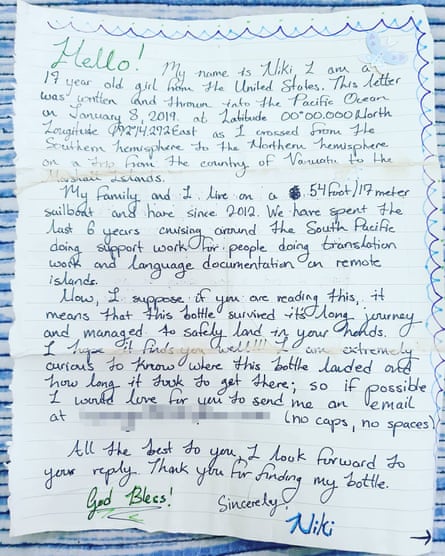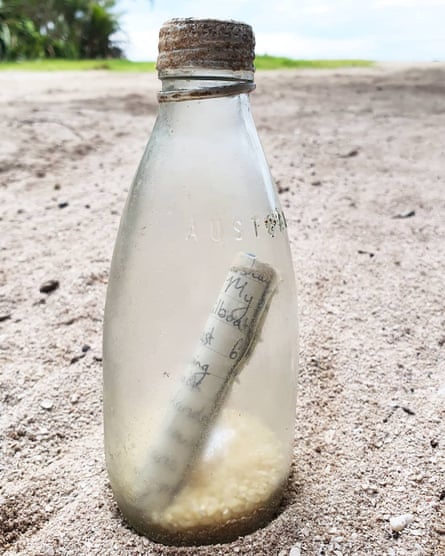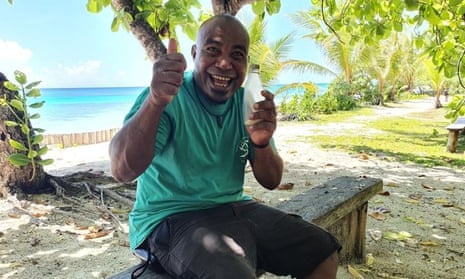This bottle was different. Glass, with its lid sealed tight, it contained a handful of rice grains and a few seashells. And a note.
In November, on the remote Conflict Islands of Papua New Guinea, conservation ranger Steven Amos was cleaning the beachfront on Panasesa island when he stumbled across something that was not thoughtlessly thrown away, but consciously sent as a message to an unknown recipient, somewhere in the world.
Nearly two years earlier, then 17-year-old American Niki Nie had dropped the message overboard as she crossed the equator, sailing with her family between Vanuatu and the Marshall Islands.
“I suppose if you are reading this, it means that this bottle has survived its long journey and managed to safely land in your hands. I hope it finds you well!
“I am extremely curious to know where this bottle landed and how long it took to get there.”

Amos, who has been working with the Conflict Islands Conservation Initiative for four years, involved in turtle conservation and plastic collection, told the Guardian he was ecstatic when he found the bottle.
“When I read the letter, I tried my best to get in touch with Miss Nie and with my colleague’s assistance – I was able to do that. I was so excited, I couldn’t sleep when I was told I was to meet her via Zoom,” Amos said.
It almost didn’t happen. The email address on the letter bounced, but a social media post found its way to Nie, who responded online. The pair were eventually able to meet online.
Nie told the Guardian: “When I threw the bottle overboard, I never imagined that I would actually meet the person who found my message.
“I also would never have guessed that it [bottle] would have landed in Alotau, Papua New Guinea – but it’s incredibly amazing.”
Amos has invited Nie to the Conflict Islands when Covid-19 restrictions ease.
Nie and her family were sailing from Vanuatu to the Marshall Islands after working for six years on humanitarian missions across the Pacific, when she threw the bottle overboard on 8 January 2019 as she crossed the equator from the southern hemisphere to the north.
“I just wanted to leave a little piece, a memory bobbing around the ocean that we spent so much time in.” She had since returned to the US to begin college, when her note found its way back into her life. The note, in its tightly sealed bottle, had travelled more than 2,500km to the remote Conflict Islands.
Amos said it was vital to conserve the remote and fragile ecosystem of the Conflict Islands, a nesting ground for numerous turtles.

“It is very important to do plastic collection on the beaches to conserve turtles and other marine life. We ensure turtles are relocated during nesting season from outer islands to where it’s safer and release them later. The increased plastic pollution has seen a decrease in the number of turtles coming to nest on the islands,” he said.
Marine biologist and zoologist at the Conflict Islands Conservation Initiative Hayley Versace told the Guardian nearly 900 female nesting Hawksbill sea turtles had been tagged since 2017 – but only three have returned.
“From the tagging, we’ve discovered that the turtles actually go back to the Great Barrier Reef in Australia to feed and forage, and only use the islands as a nesting ground.”
The Hawksbill, threatened by a degraded environment and increased levels of poaching, faces extinction within a decade on current trends.
“If we don’t change, turtles will become extinct, and without them the future won’t get to see them, and more importantly, they will be lost forever and their important role in the food chain and ecosystems in the ocean will be lost as well.”
According to PNG’s Conservation Environment and Protection authority (CEPA), the country has the highest rate of plastic mismanagement in the Pacific, with about 10 tonnes of plastic waste disposed of every day and 3,719 tonnes annually, none of which is recycled.
